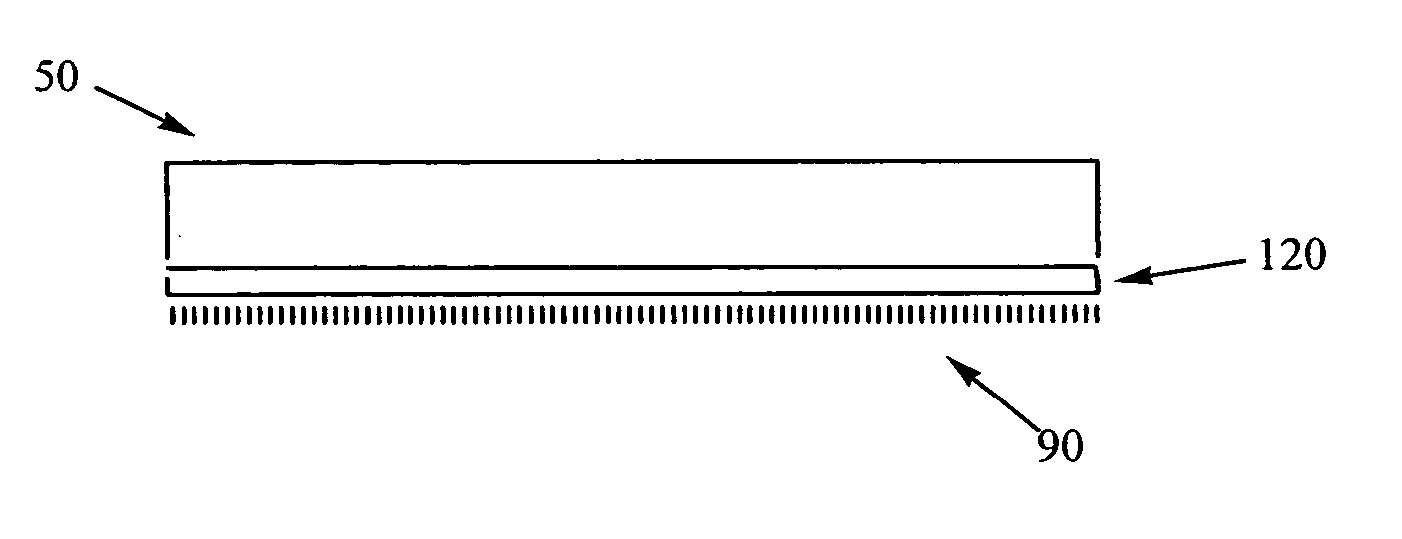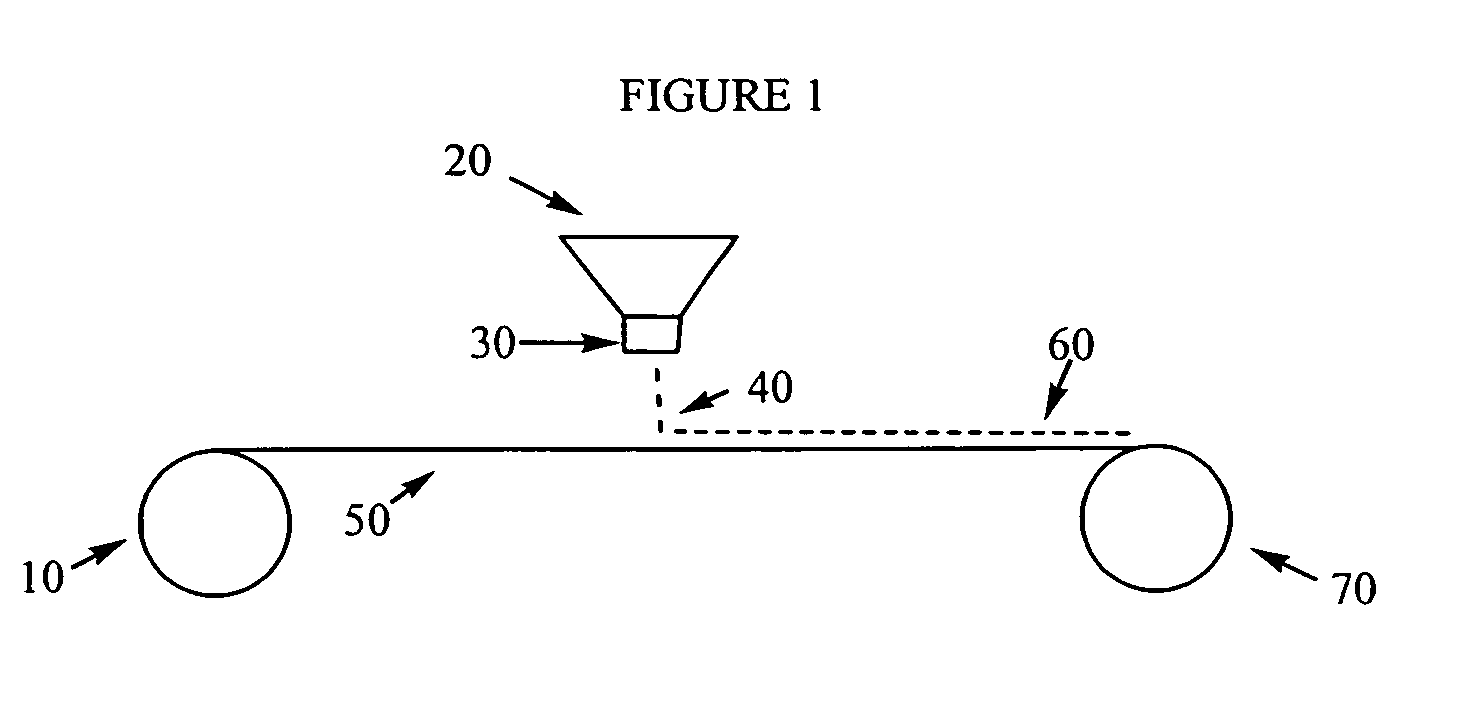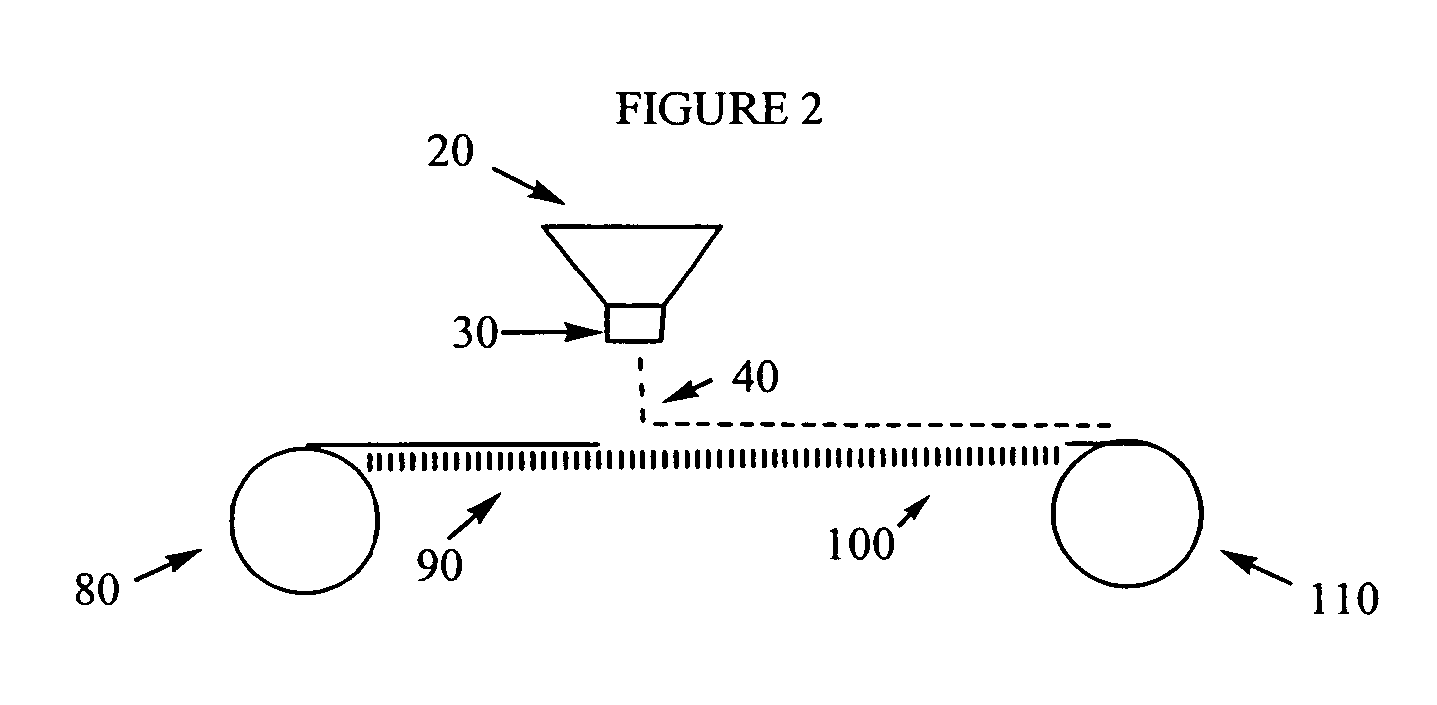Composite materials
a technology of composite materials and materials, applied in the field of fabrics, can solve the problems of increasing the weight and/or thickness of the sound attenuating material, the process is also relatively inefficient, so as to avoid the use of the polyethylene adhesive layer, avoid unnecessary process steps, and accept the sound absorption
- Summary
- Abstract
- Description
- Claims
- Application Information
AI Technical Summary
Benefits of technology
Problems solved by technology
Method used
Image
Examples
example 1
Adhesion of a Shoddy Layer to Tufted and Non-Woven Carpet Layers
[0077] Formulation 68874-00 was produced using the following:
IngredientDry phrDRSL 68957-00 Latex100Filler60Microthene MN 7010 Ground PE adhesion promoter50Surfactant.8Thickener.4% Solids58Viscosity2500
[0078] The above formulation was frothed to an application density of 90-110 g / 8 oz cup and applied to three commercially obtained carpet structures on a roll over roll 75 inch wide pilot coater.
CarpetWeightPileDesignationoz / yd2GaugeHeightClassA17.2—0.264NonwovenB13.91 / 100.214TuftedC18.05 / 640.202Tufted
[0079] Shoddy adhesion was determined by preheating the coated carpet sample at 191° C. for 6 minutes while the shoddy (6 mm, 560 gsm, recycled fiber) fabric remained at room temperature. The fabric samples were mated and transferred to a hydraulic press at room temperature between two 6 mm shims. The press daylight was closed for 1 minute, but no additional pressure was applied to the platens. Two 3″×9″ sections were d...
example 2
Adhesion of a Filled EVA Layer to Tufted and Non-Woven Carpet Layers
[0082] Latex formulations were produced using the following:
Formulation31 (Control)IngredientDry phrDry phrDRSL 68957-00 Latex100100Filler85112Pigment0.870.87Michem Prime 4983-40R200.00adhesion promoterSurfactant4.054.05Thickener.1.45% Solids57.058.0Viscosity28002800
[0083] The above formulations were frothed to an application density of 120-140 g / 8 oz cup and applied to three commercially obtained carpet samples on a roll over roll 75 inch wide pilot coater.
WeightCarpetsPileDesignationoz / yd2GaugeHeightClassCompound1B13.9 1 / 100.214Tufted1-Control1C18.0 5 / 640.202Tufted1-Control3B13.9 1 / 100.214Tufted3-Heavy LayerAdhesion3C18.0 5 / 640.202Tufted3-Heavy LayerAdhesion
[0084] Heavy layer adhesion was determined by preheating the top platen of a press to 180° C. and the bottom platen to 60° C. A 12″×12″ section of carpet was mated with an 11″×11″ section of non-backed filled EVA heavy layer. A section of 12″×12″ nonwoven ...
example 3
Impact of Surface Acid Level on Heavy Layer Adhesion
[0086] Latexes were produced following the recipe for DRSL Tylac 68957 except carboxylic acid levels were increased by replacing 1 to 1 for styrene. The experimental latexes were formulated as in Example #2 except the Michem Prime 4983-40R was omitted. The compounds were laboratory coated on standard 19 oz / yd2 nonwoven fabric. Heavy layer adhesion was then evaluated as described in Example 2. The following table shows the increase in adhesion observed by increasing the surface acid level of the latex.
Surface Acid level,Heavy Layer AdhesionLatexpartslb / inTylac 68957-27-29 control2.00.4468957-303.00.5968957-314.00.84
PUM
| Property | Measurement | Unit |
|---|---|---|
| thicknesses | aaaaa | aaaaa |
| thicknesses | aaaaa | aaaaa |
| thickness | aaaaa | aaaaa |
Abstract
Description
Claims
Application Information
 Login to View More
Login to View More - R&D
- Intellectual Property
- Life Sciences
- Materials
- Tech Scout
- Unparalleled Data Quality
- Higher Quality Content
- 60% Fewer Hallucinations
Browse by: Latest US Patents, China's latest patents, Technical Efficacy Thesaurus, Application Domain, Technology Topic, Popular Technical Reports.
© 2025 PatSnap. All rights reserved.Legal|Privacy policy|Modern Slavery Act Transparency Statement|Sitemap|About US| Contact US: help@patsnap.com



